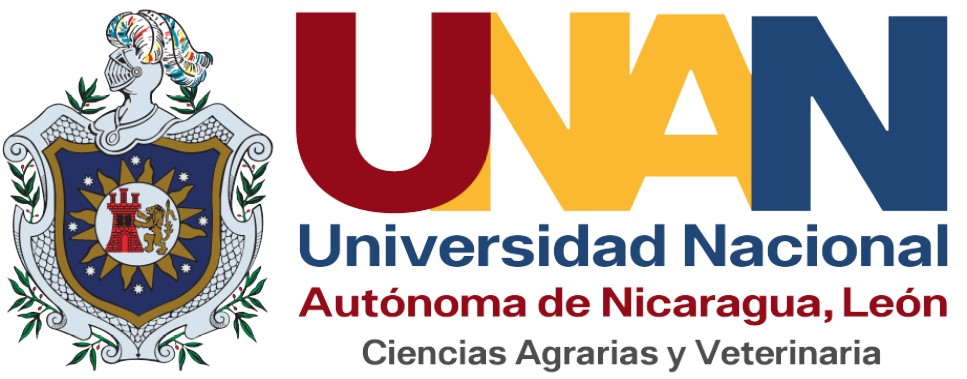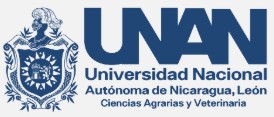Effect of three microbial consortia in corn (Zea mays L.) in Villaflores, Chiapas
DOI:
https://doi.org/10.5377/ribcc.v7i13.11424Keywords:
Corn, Microorganisms, Growth, BiomassAbstract
The present research was carried out with the aim of evaluating the effect of mountain microorganisms (MM) on growth variables and biomass production of the corn agroecosystem under agroecological management in Villaflores, Chiapas, Mexico. The microbial consortia were elaborated by the technique of reproduction and activation of MM and three different treatments were obtained: MM1 (“La Frailescana” Natural Resources Protection Area), MM2 (“La Sepultura” Biosphere Reserve), MM3 (Cerro Nambiyuguá, Villaflores municipality); and a control equivalent to the chemical fertilizer (compost + ammonium sulfate). A 4X4 latin square experimental design was used and the application of the microbial consortia was carried out at 20 and 50 days after sowing (DDS, by its acronym in spanish) with concentrations of 50% (Sol. 50% concentrated MM + 50% water) and at 60 DDS at 75% (Sol. 75 % MM concentrate + 25% water). At 35 DDS and 60 DDS, MM3 obtained significantly greater effects on the crop than the other treatments, in the case of the plant height variable. At 60 DDS, MM2 equaled MM3 and the control with stem diameter values ranging between 1.99 and 2.08 cm. The highest global dry biomass production was maintained in the MM3 treatment. The MM3 treatment, whose source of inoculum comes from the site closest to the region of the experimental area, obtained greater effects on the growth indicators and biomass production.
Downloads
Metrics
References
Ayvar-Serna, S., Díaz-Nájera, J. F., Vargas-Hernández, M., Mena-Bahena, A., Tejeda-Reyes, M. A. y Cuevas-Apresa, Z. 2020. Terra Latinoamericana, 38(1): 9-16. DOI: https://doi.org/10.28940/terra.v38i1.507
Basaglia, M., Casella, S., Peruch, U., Poggiolini, S., Vamerali, T., Mosca, G., Vanderleyden, J., de Troch, P y Nuti, M. P. 2003. Field release of genetically marked Azospirillum brasilense in association with Sorghum bicolor L. Plant Soil, 256: 281-290. DOI: https://doi.org/10.1023/A:1026198522123
Castellanos, J. Z., Uvalle-Bueno, J.X. y Aguilar-Santelises, A. 2000. Manual de interpretación de análisis de suelos y aguas. 2ª. ed. Instituto de Capacitación para la Productividad Agrícola. Colección INCAPA. Celaya, Guanajuato, México.
Castro Barquero, L., Murillo Roos, M., Uribe Lorío, L., y Mata Chinchilla, R. 2015. Inoculación al suelo con Pseudomonas fluorescens, Azospirillum oryzae, Bacillus subtilis y microorganismos de montaña y su efecto sobre un sistema de rotación soya-tomate bajo condiciones de invernadero. Agronomía Costarricense, 39(3): 21-36. https://doi.org/10.15517/rac.v39i3.21787
Campos-Martínez, A., Acosta-Sánchez, R. L., Morales-Velasco, S., & Prado, F. A. (2014). Evaluación de microorganismos de montaña (MM) en la producción de acelga en la Meseta. Biotecnología en el Sector Agropecuario y Agroindustrial, 12(1), 79-87.
García, M., & Watson, C. 2003. Herencia de la resistencia al acame de raíces en maíz dulce (Zea mays L.). Revista Científica UDO Agrícola, 3(1), 24-33
Guevara-Hernández, F., Delgado-Ruiz, F., La O-Arias, M. A., Rodríguez-Larramendi, L. A., Ortiz-Pérez, R.,
Delgado-Ruiz, J. A., Venegas-Venegas, J. A. y Pinto-Ruiz, R. 2018. Análisis comparativo energético-económico del agroecosistema maíz del bajo prácticas convencionales y de conservación en la región Frailesca, Chiapas,
México. Rev. Fac. Agron. (LUZ), 35: 343-364.
Hidalgo-Sánchez, M. G., González-Hernández, V. A., Mendoza-Onofre, L. E., Cruz-Huerta, N. y Ramírez-Ramírez, I. Desempeño de arquetipos de maíz (Zea mays L.) en dos densidades de población. Agrociencia, 54(2): 491-504. DOI: https://doi.org/10.47163/agrociencia.v54i4.2046
Kibblewhite, M. G., Ritz, K., & Swift, M. J. 2015. Soil health in agricultural systems. The Royal Society, 363. https://doi.org/10.1098/rstb.2007.2178
LAIGE-ECOSUR. 2006. Base de datos digitales. El Colegio de la Frontera Sur (ECOSUR). San Cristóbal de las Casas, Chiapas, México.
Liu, T., Song, F., Liu S. y Zhu, X. 2011. Canopy structure, light interception, and photosynthetic characteristics under different narrow-wide planting patterns in maize at silking stage. Spanish J. Agric. Res, 9: 1249-1261. https://doi.org/10.5424/sjar/20110904-050-11
López, M., Martínez Viera, R., Brossard Fabré, M., Bolívar, A., Alfonso, N., Alba, A. y Pereira Abreo, H. 2008. Efecto de biofertilizantes bacterianos sobre el crecimiento de un cultivar de maíz en dos suelos contrastantes venezolanos. Agronomía Tropical, 58(4): 391-401.
Martínez Aguilar, F. B., Guevara Hernández, F., La O Arias, M. A., Rodríguez Larramendi, L. A., Pinto Ruiz, R., & Aguilar Jiménez, C. E. 2020. Caracterización de productores de maíz e indicadores de sustentabilidad en Chiapas. Revista Mexicana de Ciencias Agrícolas, 11(5): 1031-1042. https://doi.org/10.29312/remexca.v11i5.2189
Martínez-Aguilar, F. B., Guevara-Hernández, F., Aguilar-Jiménez, C. E., Rodríguez-Larramendi, L. A., Reyes-Sosa, M. B. y La O-Arias, M. A. 2020. Caracterización físico-química y biológica del suelo cultivado con maíz en sistemas convencional, agroecológico y mixto en la Frailesca, Chiapas. Terra Latinoamericana, 38(4):871-881. DOI: https://doi.org/10.28940/terra.v38i4.793
Melgar Valdes, C. E., Barba Macías, E., Álvarez-González, C. A., Tovilla Hernández, C. y Sánchez, A. J. Efecto de microorganismos con potencial probiótico en la calidad del agua y el crecimiento de camarón Litopenaeus vannamei (Decapoda: Penaeidae) en cultivo intensivo. Revista de Biología Tropical, 61(3): 1215-1228. https://doi.org/10.15517/rbt.v61i3.11936
Shao, K., Bai, Ch., Jian, C., Hu, Y., Gong, Y., Jianying, Ch., Dai, J., Wang, Y., Ba, T., Tang, X. y Gao, G. 2019.Illumina Sequencing Reveald Soil Microbial Communities in a Chinese Alpine Grassland. Geomicrobiology Journal, 1-7. DOI: https://doi.org/10.1080/01490451.2018.1534902
SIAP. 2019. Sistema de Información Agroalimentaria de Consulta. Recuperado de https://www.gob.mx/siap/acciones-y-programas/produccion-agricola-33119
Suchini Ramírez, J. G. 2012. Innovaciones agroecológicas para una producción agropecuaria sostenible en la región del Trifinio (Primera ed.). Turrialba, C. R.: Centro Agronómico Tropical de Investigación y Enseñanza.
Umaña, S., Rodríguez, K., Rojas, C. 2017. ¿Funcionan realmente los microorganismos de montaña (MM) como estrategia de biofertilización? Un enfoque de ingeniería de biosistemas. Revista de Ciencias Ambientales (Trop J Environ Sci), 51(2): 133-144. DOI: http://dx.doi.org/10.15359/rca.51-2.7
Downloads
Published
How to Cite
Issue
Section
License
Copyright (c) 2021 Ibero-american JournalL of Bioeconomy and Climate Change e-ISSN 2410-7980

This work is licensed under a Creative Commons Attribution-NonCommercial-ShareAlike 4.0 International License.
Copyright © 2025 Rev. iberoam. bioecon. climate change. National Autonomous University of Nicaragua León (UNAN-León), Knowledge Area of Agrarian and Veterinary Sciences / Specific Area of Agroecology and Agribusiness / Center for Research in Agrarian Sciencies. Academic Directorate. Research Department. Publication and scientific events Unit.












 EDITORIAL
EDITORIAL e-ISSN
e-ISSN


 COPYRIGHT
COPYRIGHT This work is licensed under a Licencia Internacional
This work is licensed under a Licencia Internacional 












